Managerial Accounting: Comparative Analysis of Remuneration Structures
VerifiedAdded on 2023/06/07
|8
|1740
|74
Report
AI Summary
This report provides a comprehensive evaluation of the remuneration structures of two ASX-listed organizations in Australia: Reliance Worldwide and Alcidion Group Limited. The analysis considers various aspects of executive compensation, including fixed payments, short-term incentives, and long-term incentives. The remuneration structures are designed to align the goals of directors and executives with the objectives of shareholders and overall business performance. While both organizations utilize similar incentive structures, differences in financial health and shareholder returns are noted. Reliance Worldwide demonstrates a positive correlation between executive pay and share price/net income, whereas Alcidion Group Limited shows an increase in executive payments despite a decline in share price. The report also examines the two-tier structure of annual incentives, comprising target and stretch components, and assesses the impact of short-term and long-term incentives on executive performance in both organizations, ultimately concluding that Reliance Worldwide exhibits a more favorable position in terms of executive compensation and financial performance.
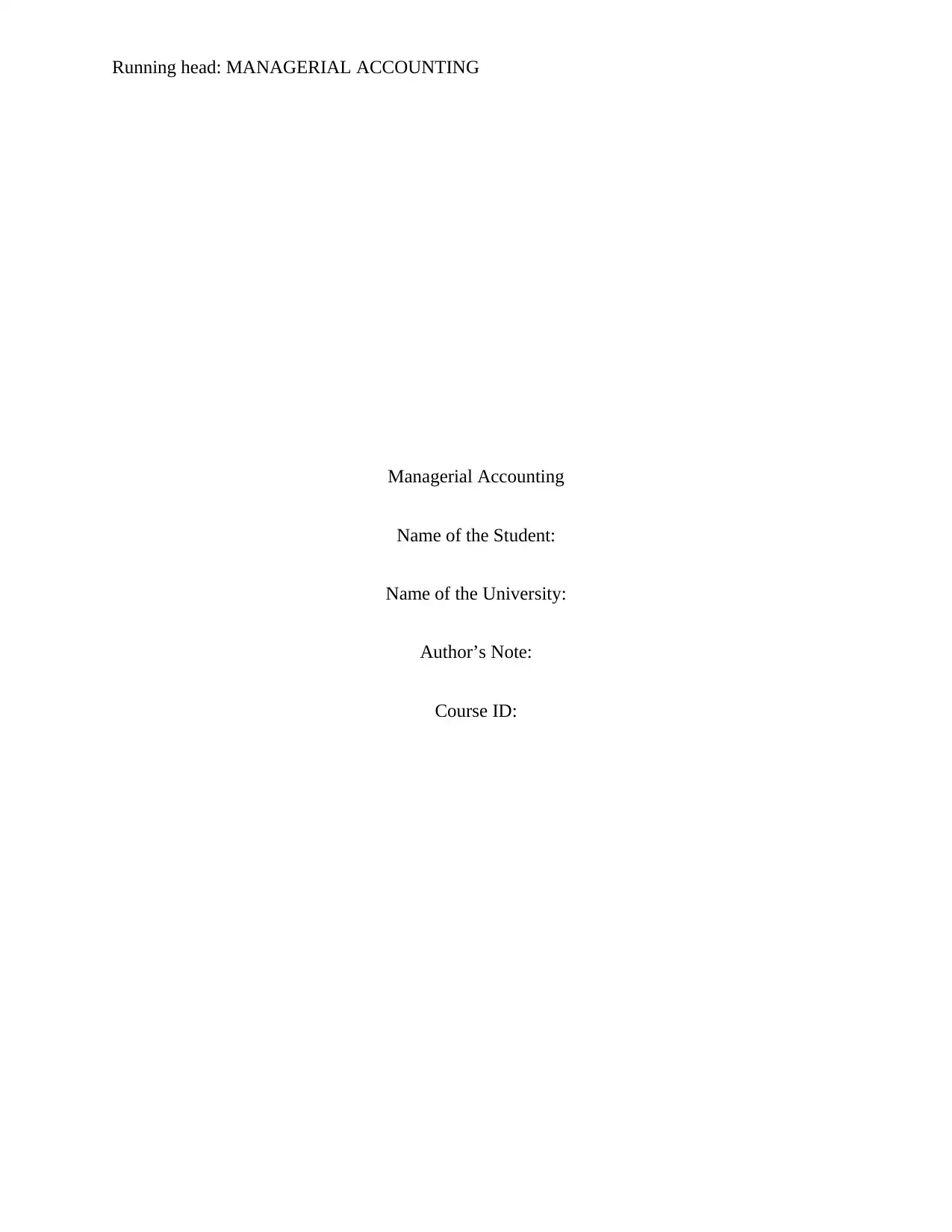
Running head: MANAGERIAL ACCOUNTING
Managerial Accounting
Name of the Student:
Name of the University:
Author’s Note:
Course ID:
Managerial Accounting
Name of the Student:
Name of the University:
Author’s Note:
Course ID:
Paraphrase This Document
Need a fresh take? Get an instant paraphrase of this document with our AI Paraphraser
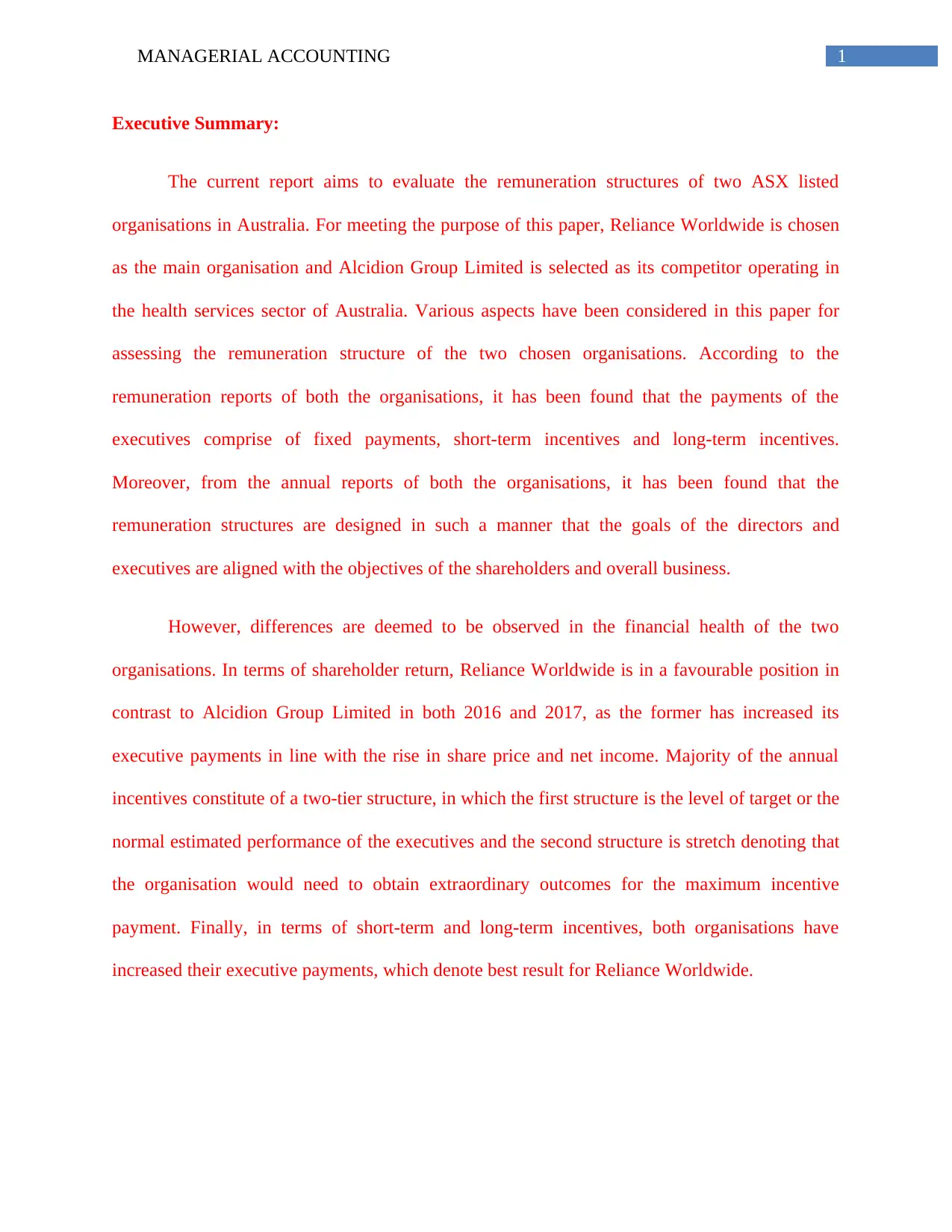
1MANAGERIAL ACCOUNTING
Executive Summary:
The current report aims to evaluate the remuneration structures of two ASX listed
organisations in Australia. For meeting the purpose of this paper, Reliance Worldwide is chosen
as the main organisation and Alcidion Group Limited is selected as its competitor operating in
the health services sector of Australia. Various aspects have been considered in this paper for
assessing the remuneration structure of the two chosen organisations. According to the
remuneration reports of both the organisations, it has been found that the payments of the
executives comprise of fixed payments, short-term incentives and long-term incentives.
Moreover, from the annual reports of both the organisations, it has been found that the
remuneration structures are designed in such a manner that the goals of the directors and
executives are aligned with the objectives of the shareholders and overall business.
However, differences are deemed to be observed in the financial health of the two
organisations. In terms of shareholder return, Reliance Worldwide is in a favourable position in
contrast to Alcidion Group Limited in both 2016 and 2017, as the former has increased its
executive payments in line with the rise in share price and net income. Majority of the annual
incentives constitute of a two-tier structure, in which the first structure is the level of target or the
normal estimated performance of the executives and the second structure is stretch denoting that
the organisation would need to obtain extraordinary outcomes for the maximum incentive
payment. Finally, in terms of short-term and long-term incentives, both organisations have
increased their executive payments, which denote best result for Reliance Worldwide.
Executive Summary:
The current report aims to evaluate the remuneration structures of two ASX listed
organisations in Australia. For meeting the purpose of this paper, Reliance Worldwide is chosen
as the main organisation and Alcidion Group Limited is selected as its competitor operating in
the health services sector of Australia. Various aspects have been considered in this paper for
assessing the remuneration structure of the two chosen organisations. According to the
remuneration reports of both the organisations, it has been found that the payments of the
executives comprise of fixed payments, short-term incentives and long-term incentives.
Moreover, from the annual reports of both the organisations, it has been found that the
remuneration structures are designed in such a manner that the goals of the directors and
executives are aligned with the objectives of the shareholders and overall business.
However, differences are deemed to be observed in the financial health of the two
organisations. In terms of shareholder return, Reliance Worldwide is in a favourable position in
contrast to Alcidion Group Limited in both 2016 and 2017, as the former has increased its
executive payments in line with the rise in share price and net income. Majority of the annual
incentives constitute of a two-tier structure, in which the first structure is the level of target or the
normal estimated performance of the executives and the second structure is stretch denoting that
the organisation would need to obtain extraordinary outcomes for the maximum incentive
payment. Finally, in terms of short-term and long-term incentives, both organisations have
increased their executive payments, which denote best result for Reliance Worldwide.
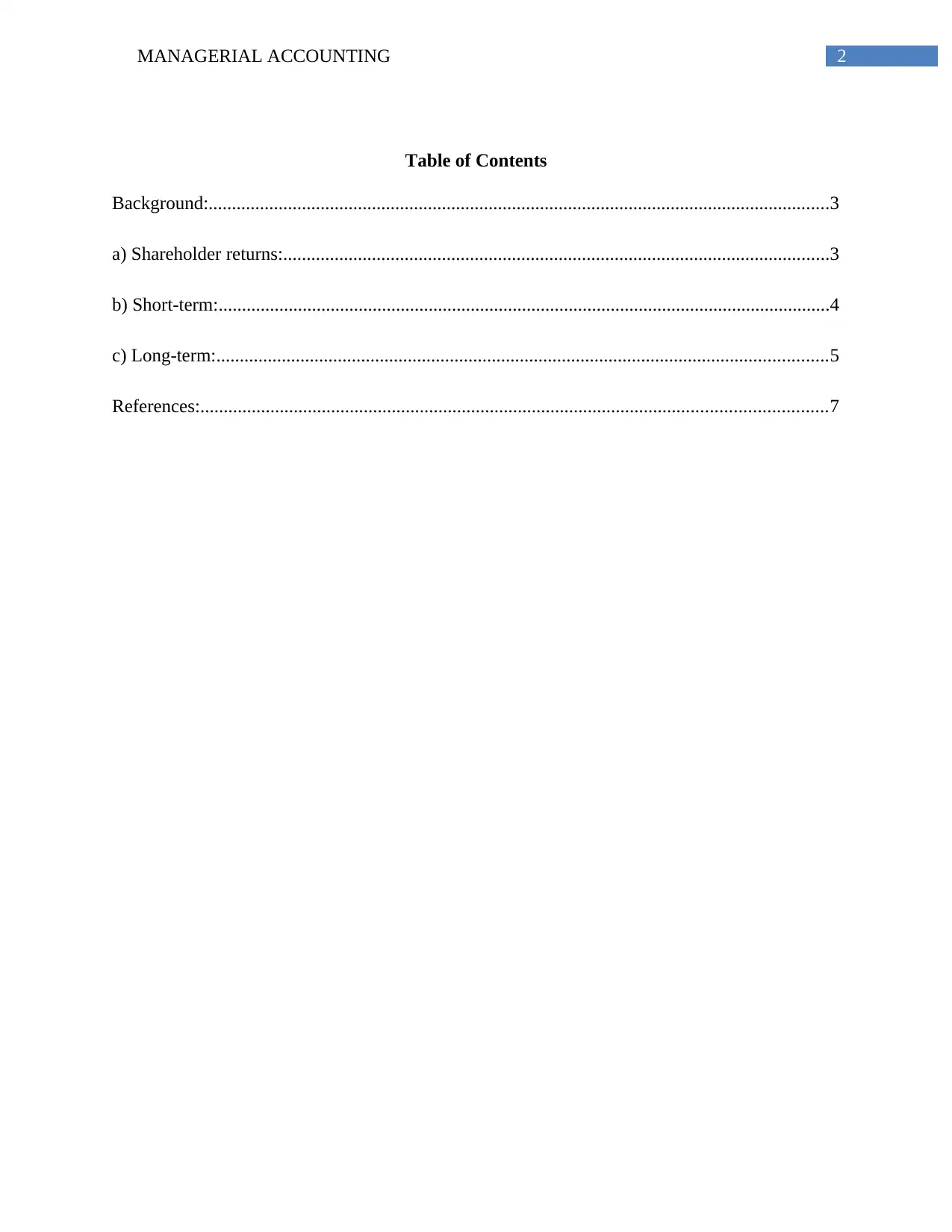
2MANAGERIAL ACCOUNTING
Table of Contents
Background:.....................................................................................................................................3
a) Shareholder returns:.....................................................................................................................3
b) Short-term:...................................................................................................................................4
c) Long-term:...................................................................................................................................5
References:......................................................................................................................................7
Table of Contents
Background:.....................................................................................................................................3
a) Shareholder returns:.....................................................................................................................3
b) Short-term:...................................................................................................................................4
c) Long-term:...................................................................................................................................5
References:......................................................................................................................................7
⊘ This is a preview!⊘
Do you want full access?
Subscribe today to unlock all pages.

Trusted by 1+ million students worldwide
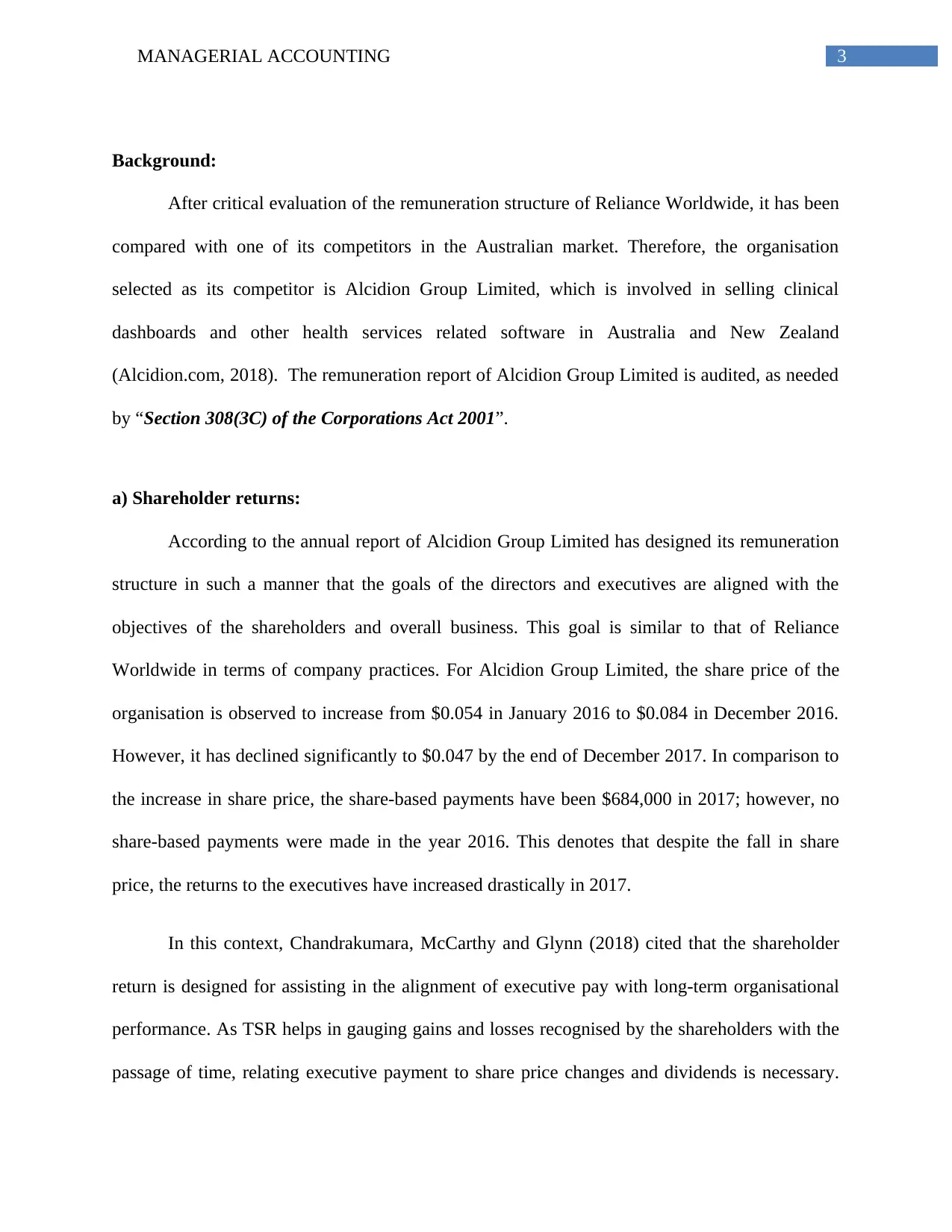
3MANAGERIAL ACCOUNTING
Background:
After critical evaluation of the remuneration structure of Reliance Worldwide, it has been
compared with one of its competitors in the Australian market. Therefore, the organisation
selected as its competitor is Alcidion Group Limited, which is involved in selling clinical
dashboards and other health services related software in Australia and New Zealand
(Alcidion.com, 2018). The remuneration report of Alcidion Group Limited is audited, as needed
by “Section 308(3C) of the Corporations Act 2001”.
a) Shareholder returns:
According to the annual report of Alcidion Group Limited has designed its remuneration
structure in such a manner that the goals of the directors and executives are aligned with the
objectives of the shareholders and overall business. This goal is similar to that of Reliance
Worldwide in terms of company practices. For Alcidion Group Limited, the share price of the
organisation is observed to increase from $0.054 in January 2016 to $0.084 in December 2016.
However, it has declined significantly to $0.047 by the end of December 2017. In comparison to
the increase in share price, the share-based payments have been $684,000 in 2017; however, no
share-based payments were made in the year 2016. This denotes that despite the fall in share
price, the returns to the executives have increased drastically in 2017.
In this context, Chandrakumara, McCarthy and Glynn (2018) cited that the shareholder
return is designed for assisting in the alignment of executive pay with long-term organisational
performance. As TSR helps in gauging gains and losses recognised by the shareholders with the
passage of time, relating executive payment to share price changes and dividends is necessary.
Background:
After critical evaluation of the remuneration structure of Reliance Worldwide, it has been
compared with one of its competitors in the Australian market. Therefore, the organisation
selected as its competitor is Alcidion Group Limited, which is involved in selling clinical
dashboards and other health services related software in Australia and New Zealand
(Alcidion.com, 2018). The remuneration report of Alcidion Group Limited is audited, as needed
by “Section 308(3C) of the Corporations Act 2001”.
a) Shareholder returns:
According to the annual report of Alcidion Group Limited has designed its remuneration
structure in such a manner that the goals of the directors and executives are aligned with the
objectives of the shareholders and overall business. This goal is similar to that of Reliance
Worldwide in terms of company practices. For Alcidion Group Limited, the share price of the
organisation is observed to increase from $0.054 in January 2016 to $0.084 in December 2016.
However, it has declined significantly to $0.047 by the end of December 2017. In comparison to
the increase in share price, the share-based payments have been $684,000 in 2017; however, no
share-based payments were made in the year 2016. This denotes that despite the fall in share
price, the returns to the executives have increased drastically in 2017.
In this context, Chandrakumara, McCarthy and Glynn (2018) cited that the shareholder
return is designed for assisting in the alignment of executive pay with long-term organisational
performance. As TSR helps in gauging gains and losses recognised by the shareholders with the
passage of time, relating executive payment to share price changes and dividends is necessary.
Paraphrase This Document
Need a fresh take? Get an instant paraphrase of this document with our AI Paraphraser
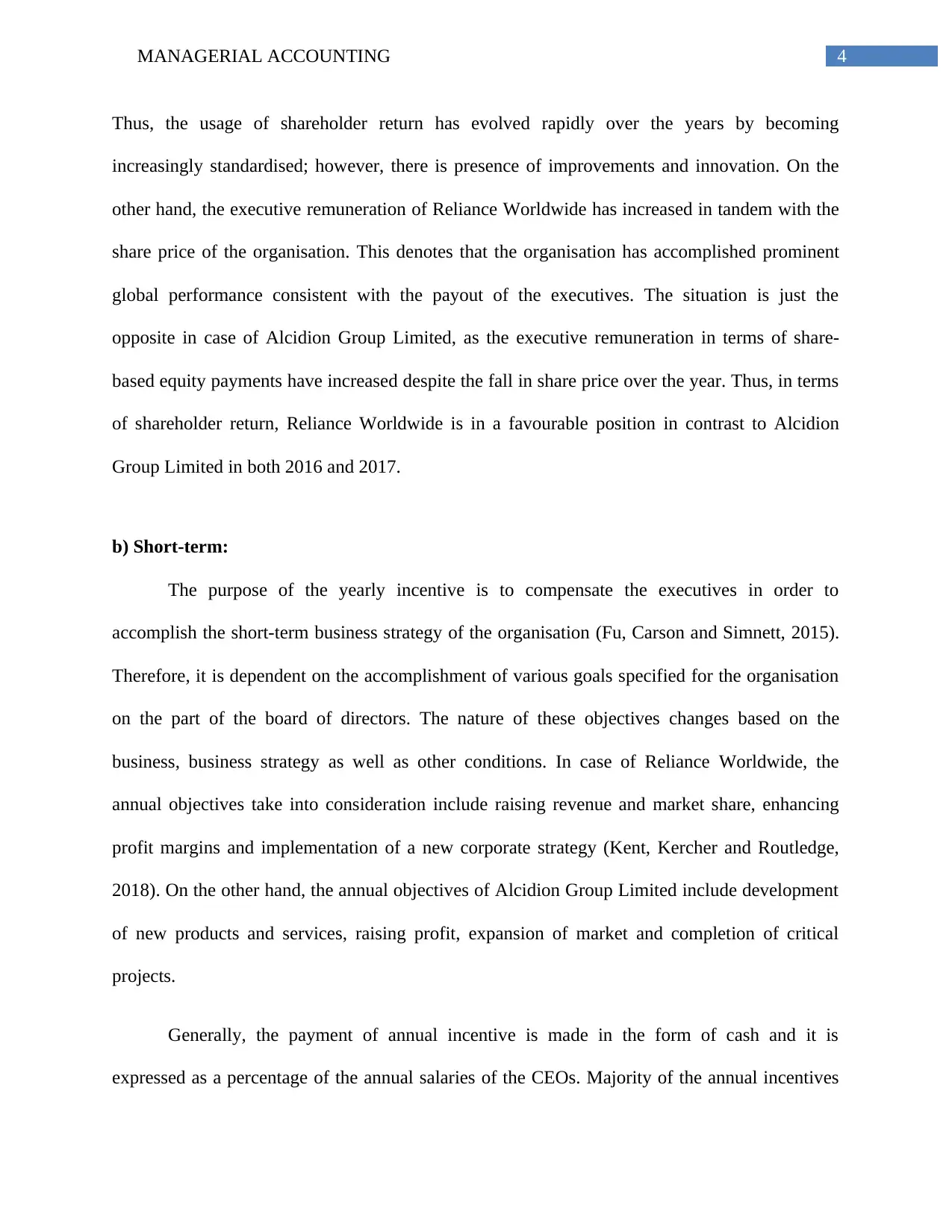
4MANAGERIAL ACCOUNTING
Thus, the usage of shareholder return has evolved rapidly over the years by becoming
increasingly standardised; however, there is presence of improvements and innovation. On the
other hand, the executive remuneration of Reliance Worldwide has increased in tandem with the
share price of the organisation. This denotes that the organisation has accomplished prominent
global performance consistent with the payout of the executives. The situation is just the
opposite in case of Alcidion Group Limited, as the executive remuneration in terms of share-
based equity payments have increased despite the fall in share price over the year. Thus, in terms
of shareholder return, Reliance Worldwide is in a favourable position in contrast to Alcidion
Group Limited in both 2016 and 2017.
b) Short-term:
The purpose of the yearly incentive is to compensate the executives in order to
accomplish the short-term business strategy of the organisation (Fu, Carson and Simnett, 2015).
Therefore, it is dependent on the accomplishment of various goals specified for the organisation
on the part of the board of directors. The nature of these objectives changes based on the
business, business strategy as well as other conditions. In case of Reliance Worldwide, the
annual objectives take into consideration include raising revenue and market share, enhancing
profit margins and implementation of a new corporate strategy (Kent, Kercher and Routledge,
2018). On the other hand, the annual objectives of Alcidion Group Limited include development
of new products and services, raising profit, expansion of market and completion of critical
projects.
Generally, the payment of annual incentive is made in the form of cash and it is
expressed as a percentage of the annual salaries of the CEOs. Majority of the annual incentives
Thus, the usage of shareholder return has evolved rapidly over the years by becoming
increasingly standardised; however, there is presence of improvements and innovation. On the
other hand, the executive remuneration of Reliance Worldwide has increased in tandem with the
share price of the organisation. This denotes that the organisation has accomplished prominent
global performance consistent with the payout of the executives. The situation is just the
opposite in case of Alcidion Group Limited, as the executive remuneration in terms of share-
based equity payments have increased despite the fall in share price over the year. Thus, in terms
of shareholder return, Reliance Worldwide is in a favourable position in contrast to Alcidion
Group Limited in both 2016 and 2017.
b) Short-term:
The purpose of the yearly incentive is to compensate the executives in order to
accomplish the short-term business strategy of the organisation (Fu, Carson and Simnett, 2015).
Therefore, it is dependent on the accomplishment of various goals specified for the organisation
on the part of the board of directors. The nature of these objectives changes based on the
business, business strategy as well as other conditions. In case of Reliance Worldwide, the
annual objectives take into consideration include raising revenue and market share, enhancing
profit margins and implementation of a new corporate strategy (Kent, Kercher and Routledge,
2018). On the other hand, the annual objectives of Alcidion Group Limited include development
of new products and services, raising profit, expansion of market and completion of critical
projects.
Generally, the payment of annual incentive is made in the form of cash and it is
expressed as a percentage of the annual salaries of the CEOs. Majority of the annual incentives
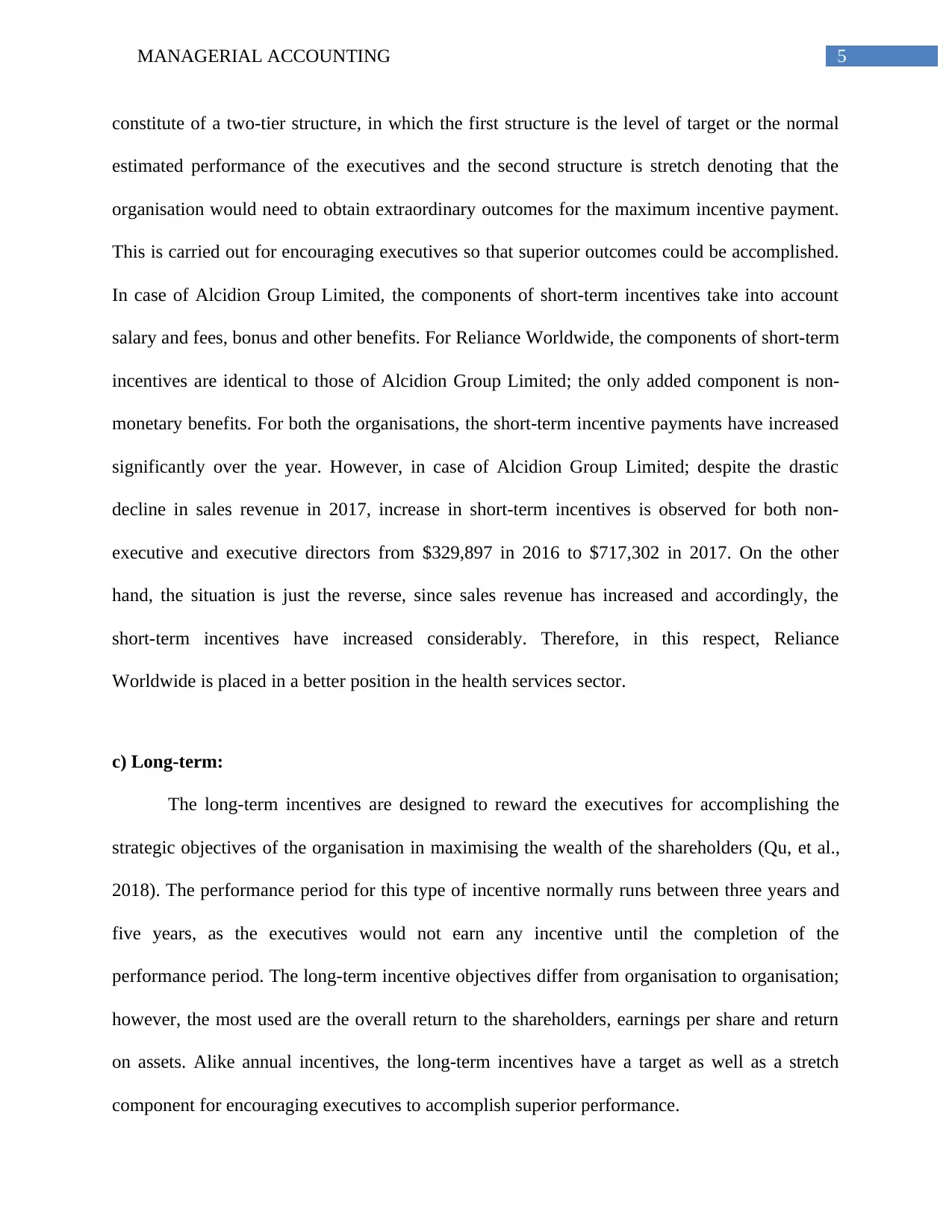
5MANAGERIAL ACCOUNTING
constitute of a two-tier structure, in which the first structure is the level of target or the normal
estimated performance of the executives and the second structure is stretch denoting that the
organisation would need to obtain extraordinary outcomes for the maximum incentive payment.
This is carried out for encouraging executives so that superior outcomes could be accomplished.
In case of Alcidion Group Limited, the components of short-term incentives take into account
salary and fees, bonus and other benefits. For Reliance Worldwide, the components of short-term
incentives are identical to those of Alcidion Group Limited; the only added component is non-
monetary benefits. For both the organisations, the short-term incentive payments have increased
significantly over the year. However, in case of Alcidion Group Limited; despite the drastic
decline in sales revenue in 2017, increase in short-term incentives is observed for both non-
executive and executive directors from $329,897 in 2016 to $717,302 in 2017. On the other
hand, the situation is just the reverse, since sales revenue has increased and accordingly, the
short-term incentives have increased considerably. Therefore, in this respect, Reliance
Worldwide is placed in a better position in the health services sector.
c) Long-term:
The long-term incentives are designed to reward the executives for accomplishing the
strategic objectives of the organisation in maximising the wealth of the shareholders (Qu, et al.,
2018). The performance period for this type of incentive normally runs between three years and
five years, as the executives would not earn any incentive until the completion of the
performance period. The long-term incentive objectives differ from organisation to organisation;
however, the most used are the overall return to the shareholders, earnings per share and return
on assets. Alike annual incentives, the long-term incentives have a target as well as a stretch
component for encouraging executives to accomplish superior performance.
constitute of a two-tier structure, in which the first structure is the level of target or the normal
estimated performance of the executives and the second structure is stretch denoting that the
organisation would need to obtain extraordinary outcomes for the maximum incentive payment.
This is carried out for encouraging executives so that superior outcomes could be accomplished.
In case of Alcidion Group Limited, the components of short-term incentives take into account
salary and fees, bonus and other benefits. For Reliance Worldwide, the components of short-term
incentives are identical to those of Alcidion Group Limited; the only added component is non-
monetary benefits. For both the organisations, the short-term incentive payments have increased
significantly over the year. However, in case of Alcidion Group Limited; despite the drastic
decline in sales revenue in 2017, increase in short-term incentives is observed for both non-
executive and executive directors from $329,897 in 2016 to $717,302 in 2017. On the other
hand, the situation is just the reverse, since sales revenue has increased and accordingly, the
short-term incentives have increased considerably. Therefore, in this respect, Reliance
Worldwide is placed in a better position in the health services sector.
c) Long-term:
The long-term incentives are designed to reward the executives for accomplishing the
strategic objectives of the organisation in maximising the wealth of the shareholders (Qu, et al.,
2018). The performance period for this type of incentive normally runs between three years and
five years, as the executives would not earn any incentive until the completion of the
performance period. The long-term incentive objectives differ from organisation to organisation;
however, the most used are the overall return to the shareholders, earnings per share and return
on assets. Alike annual incentives, the long-term incentives have a target as well as a stretch
component for encouraging executives to accomplish superior performance.
⊘ This is a preview!⊘
Do you want full access?
Subscribe today to unlock all pages.

Trusted by 1+ million students worldwide
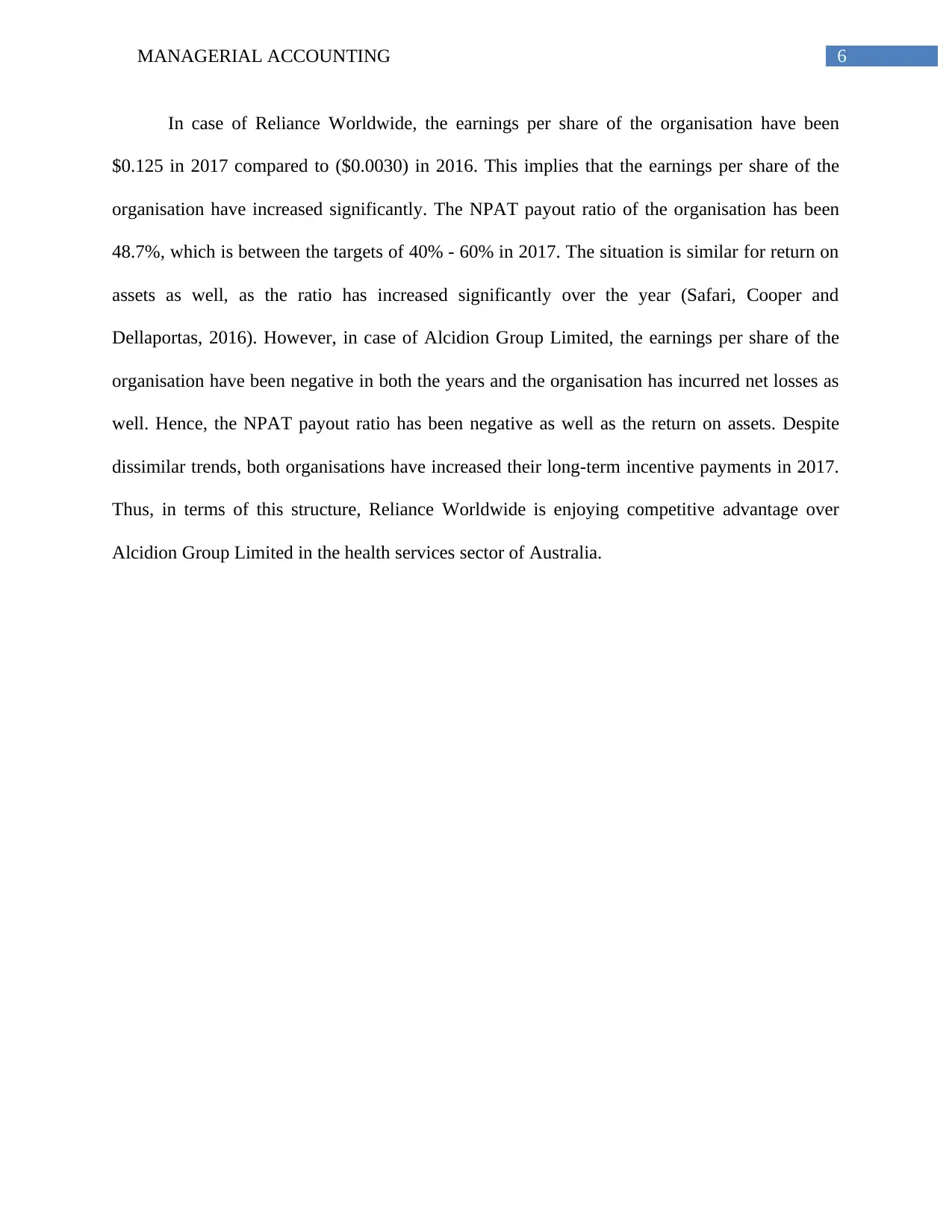
6MANAGERIAL ACCOUNTING
In case of Reliance Worldwide, the earnings per share of the organisation have been
$0.125 in 2017 compared to ($0.0030) in 2016. This implies that the earnings per share of the
organisation have increased significantly. The NPAT payout ratio of the organisation has been
48.7%, which is between the targets of 40% - 60% in 2017. The situation is similar for return on
assets as well, as the ratio has increased significantly over the year (Safari, Cooper and
Dellaportas, 2016). However, in case of Alcidion Group Limited, the earnings per share of the
organisation have been negative in both the years and the organisation has incurred net losses as
well. Hence, the NPAT payout ratio has been negative as well as the return on assets. Despite
dissimilar trends, both organisations have increased their long-term incentive payments in 2017.
Thus, in terms of this structure, Reliance Worldwide is enjoying competitive advantage over
Alcidion Group Limited in the health services sector of Australia.
In case of Reliance Worldwide, the earnings per share of the organisation have been
$0.125 in 2017 compared to ($0.0030) in 2016. This implies that the earnings per share of the
organisation have increased significantly. The NPAT payout ratio of the organisation has been
48.7%, which is between the targets of 40% - 60% in 2017. The situation is similar for return on
assets as well, as the ratio has increased significantly over the year (Safari, Cooper and
Dellaportas, 2016). However, in case of Alcidion Group Limited, the earnings per share of the
organisation have been negative in both the years and the organisation has incurred net losses as
well. Hence, the NPAT payout ratio has been negative as well as the return on assets. Despite
dissimilar trends, both organisations have increased their long-term incentive payments in 2017.
Thus, in terms of this structure, Reliance Worldwide is enjoying competitive advantage over
Alcidion Group Limited in the health services sector of Australia.
Paraphrase This Document
Need a fresh take? Get an instant paraphrase of this document with our AI Paraphraser
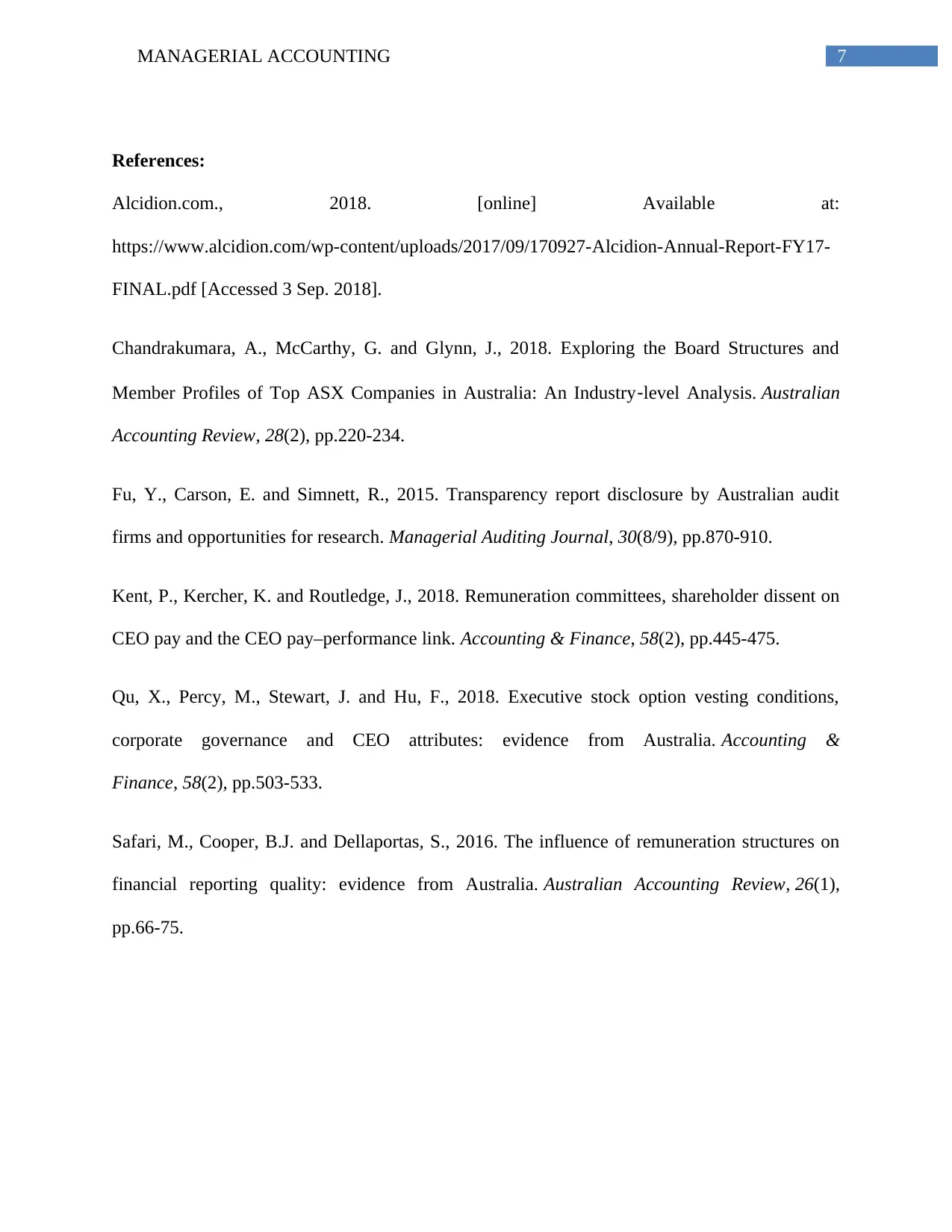
7MANAGERIAL ACCOUNTING
References:
Alcidion.com., 2018. [online] Available at:
https://www.alcidion.com/wp-content/uploads/2017/09/170927-Alcidion-Annual-Report-FY17-
FINAL.pdf [Accessed 3 Sep. 2018].
Chandrakumara, A., McCarthy, G. and Glynn, J., 2018. Exploring the Board Structures and
Member Profiles of Top ASX Companies in Australia: An Industry‐level Analysis. Australian
Accounting Review, 28(2), pp.220-234.
Fu, Y., Carson, E. and Simnett, R., 2015. Transparency report disclosure by Australian audit
firms and opportunities for research. Managerial Auditing Journal, 30(8/9), pp.870-910.
Kent, P., Kercher, K. and Routledge, J., 2018. Remuneration committees, shareholder dissent on
CEO pay and the CEO pay–performance link. Accounting & Finance, 58(2), pp.445-475.
Qu, X., Percy, M., Stewart, J. and Hu, F., 2018. Executive stock option vesting conditions,
corporate governance and CEO attributes: evidence from Australia. Accounting &
Finance, 58(2), pp.503-533.
Safari, M., Cooper, B.J. and Dellaportas, S., 2016. The influence of remuneration structures on
financial reporting quality: evidence from Australia. Australian Accounting Review, 26(1),
pp.66-75.
References:
Alcidion.com., 2018. [online] Available at:
https://www.alcidion.com/wp-content/uploads/2017/09/170927-Alcidion-Annual-Report-FY17-
FINAL.pdf [Accessed 3 Sep. 2018].
Chandrakumara, A., McCarthy, G. and Glynn, J., 2018. Exploring the Board Structures and
Member Profiles of Top ASX Companies in Australia: An Industry‐level Analysis. Australian
Accounting Review, 28(2), pp.220-234.
Fu, Y., Carson, E. and Simnett, R., 2015. Transparency report disclosure by Australian audit
firms and opportunities for research. Managerial Auditing Journal, 30(8/9), pp.870-910.
Kent, P., Kercher, K. and Routledge, J., 2018. Remuneration committees, shareholder dissent on
CEO pay and the CEO pay–performance link. Accounting & Finance, 58(2), pp.445-475.
Qu, X., Percy, M., Stewart, J. and Hu, F., 2018. Executive stock option vesting conditions,
corporate governance and CEO attributes: evidence from Australia. Accounting &
Finance, 58(2), pp.503-533.
Safari, M., Cooper, B.J. and Dellaportas, S., 2016. The influence of remuneration structures on
financial reporting quality: evidence from Australia. Australian Accounting Review, 26(1),
pp.66-75.
1 out of 8
Related Documents
Your All-in-One AI-Powered Toolkit for Academic Success.
+13062052269
info@desklib.com
Available 24*7 on WhatsApp / Email
![[object Object]](/_next/static/media/star-bottom.7253800d.svg)
Unlock your academic potential
Copyright © 2020–2025 A2Z Services. All Rights Reserved. Developed and managed by ZUCOL.




